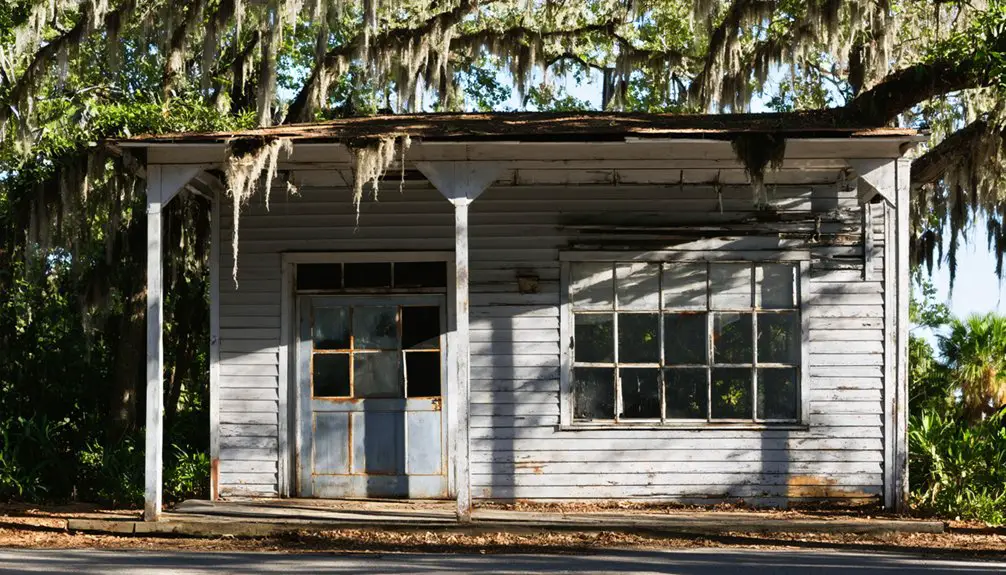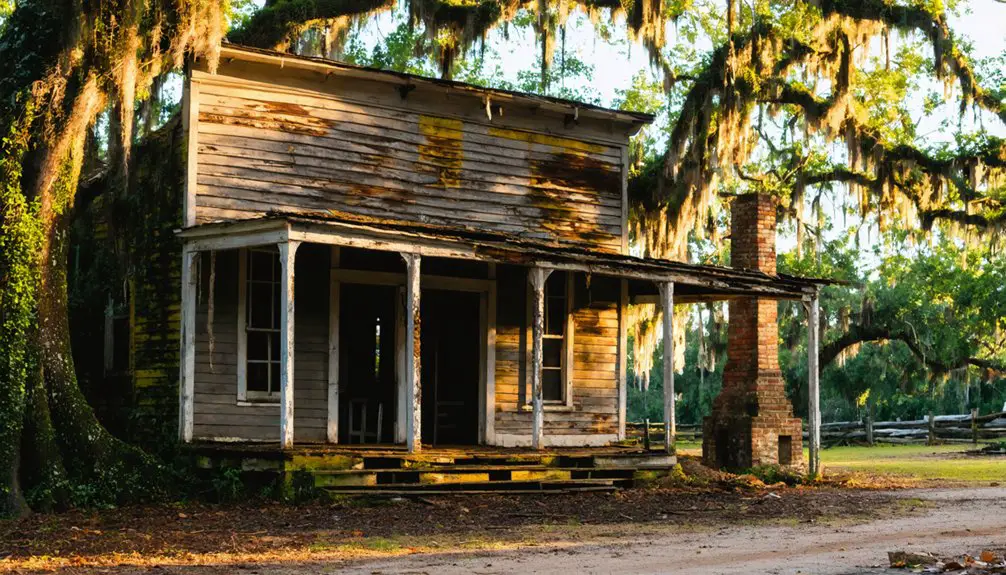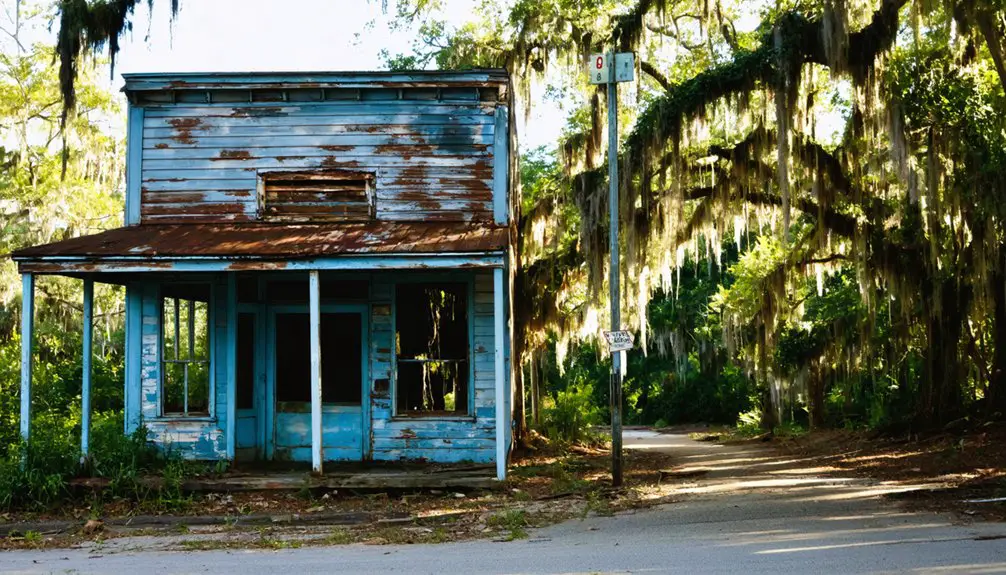You’ll find Kerr City tucked away in Marion County’s Ocala National Forest, along Lake Kerr’s shores. Founded in 1884 by George Smiley, this once-thriving citrus community boasted a hotel, sawmill, and post office until the devastating Great Freeze of 1894-1895 forced most residents to abandon their homes. Today, thanks to the Smiley family’s stewardship, 14 historic buildings remain preserved, including Florida’s oldest Texaco station. The town’s empty structures hold fascinating tales of pioneer life and mysterious encounters.
Key Takeaways
- Kerr City was established in 1884 by George Smiley near Lake Kerr, Florida, thriving as a citrus-focused community of 100 residents.
- The Great Freeze of 1894-1895 devastated the town’s citrus industry, causing mass exodus of families and economic collapse.
- After the freeze, George Smiley acquired abandoned properties, and his family later preserved 14 historic buildings.
- The town was listed on the National Register of Historic Places in 1995, with five buildings receiving special recognition.
- Visitors report supernatural encounters, including phantom footsteps and shadowy figures around the abandoned structures.
The Birth of a Southern Citrus Haven
When George Smiley founded Kerr City in 1884 on 205 acres near Lake Kerr in eastern Marion County, Florida, he established what would become one of the region’s most promising citrus settlements.
You’d have found a vibrant community of around 100 residents embracing citrus innovations through pioneering grafting techniques that transformed former cotton plantations into thriving orange groves.
The town’s strategic position on a stagecoach route connected you to both the St. Johns River and Ocala, while its infrastructure – including a post office, hotel, sawmill, and general store – supported your independence. The historic schoolhouse and church served as central gathering places for the growing community.
A thriving town along vital trade routes, Kerr City’s amenities offered settlers both connection and self-sufficiency in frontier Florida.
The community’s resilience showed in its early adoption of modern technology, becoming one of Marion County’s first settlements to welcome an automobile. The Swan and Henley families were among the prominent early settlers who helped establish the town’s strong foundation.
The fertile soil and clear lake waters promised prosperity for those seeking their fortune in Florida’s booming citrus industry.
From Cotton Fields to Orange Groves
The Civil War era left its mark on the future site of Kerr City, where cotton plantations once dominated the landscape.
By the 1880s, you’d have witnessed a remarkable transformation as cultural influences from northern settlers reshaped local agricultural practices. The switch to citrus cultivation proved revolutionary, with property owners embracing innovative grafting techniques that combined sweet orange cuttings with native sour orange rootstock.
You’ll find that Marion County’s transformation was particularly striking around Lake Kerr, where ambitious farmers capitalized on the area’s perfect growing conditions. These agricultural developments helped establish early Florida settlements that would shape the region’s future. The Great Freeze of 1894-1895 would ultimately devastate these thriving citrus operations.
The rising demand for oranges drew enterprising settlers from the North, who saw freedom and opportunity in Florida’s burgeoning fruit industry. Together, they’d establish a thriving community that would soon boast modern amenities and profitable citrus operations.
Daily Life in Early Kerr City
As northern settlers established themselves in Kerr City during the 1880s, you’d have found a bustling community of roughly 100 residents living among carefully platted streets named after U.S. states.
You could’ve started your day at the general store, picking up supplies before heading to work at the sawmill or tending your orange groves. The three-story Lake Kerr House hotel served as a prime location for community gatherings, where you’d mingle with stagecoach travelers passing through on their way to Ocala. Sadly, the hotel burned down in 1907, marking a significant loss for the town.
Stagecoach passengers mingled with locals at Lake Kerr House after long days at the sawmill and orange groves.
After work, you might’ve attended services or classes at the combination church-schoolhouse, a demonstration of the town’s resourceful spirit. The local post office operated continuously from 1884 to 1942, serving as a vital communication hub for residents.
Early industries centered around cotton plantations initially, but the promise of citrus cultivation soon transformed the local economy.
The Economic Engine Behind the Town
While other Florida communities relied on cotton in the 1880s, you’d find Kerr City’s pioneers focusing on citrus agriculture, particularly orange groves that shipped from their strategic position along the stagecoach route between the St. John’s River and Ocala.
You’ll note the Lake Kerr House hotel, built in 1885, served as an essential stopover for travelers and merchants moving through the region, generating steady income for the growing settlement. The town’s impressive development included a post office and schoolhouse, establishing it as a promising hub for the area.
The town’s sawmill processed timber from surrounding forests, supporting both local construction needs and regional trade, creating a diverse economic foundation beyond just agriculture.
Cotton to Citrus Shift
During Florida’s Civil War era, Kerr City began its economic journey as a cotton plantation before evolving into a thriving citrus community. You’ll find that this agricultural shift reflected broader changes sweeping through Florida’s landscape at the time.
The town’s strategic location near Lake Kerr and established stage routes made it an ideal spot for an economic transformation. As settlers abandoned cotton farming, they discovered that the area’s conditions were perfect for orange groves.
Transportation Hub Economics
Since its founding in 1884, Kerr City flourished as an essential transportation hub along the strategic stagecoach route connecting Palatka to Tampa via the St. John’s River crossing.
You’d find a bustling stagecoach economy centered around the post office, general store, and hotel, serving travelers and merchants moving between northern Florida waterways and inland destinations.
The town’s transportation evolution reflected the changing times, from wagon trails to stagecoach routes, and eventually to early automobiles.
You can still see evidence of this progression in Florida’s oldest Texaco station, built in 1925.
The hub’s strategic position attracted settlers and diverse businesses, creating a vibrant economic engine that moved citrus, cotton, and other goods across the region until the devastating Great Freeze of 1894-1895.
Hotel and Sawmill Operations
The economic backbone of Kerr City took shape in 1885 with the construction of two major enterprises: the Lake Kerr House hotel and the local sawmill.
Dr. Junis Terry’s three-story hotel operations served travelers between St. John’s River and Ocala, while the sawmill impact transformed virgin pine forests into building materials for the growing town.
Consider these key aspects of Kerr City’s industrial might:
- The Lake Kerr House hotel stood as the town’s crown jewel until its destruction by arson in 1907.
- Local sawmill supported 100 residents through lumber production.
- Both enterprises fueled the town’s stagecoach stop economy.
- The devastating freezes of 1894-1895 crippled both operations.
- George Smiley acquired the abandoned properties, but couldn’t revive the failing enterprises.
These ventures ultimately succumbed to nature’s fury, marking the beginning of Kerr City’s decline into a ghost town.
A Devastating Winter’s Impact
Devastating Florida’s citrus industry with unprecedented ferocity, the Great Freeze of 1894-1895 struck Kerr City’s agricultural heart, destroying its orange groves and economic foundation virtually overnight.
The town’s vulnerability to climatic extremes became painfully clear as temperatures plummeted, wiping out the citrus crops that had replaced the area’s former cotton plantations.
You’d have witnessed a mass exodus as families who’d built their lives around orange cultivation – the Swans, Henleys, Terrys, and others – abandoned their homes seeking better opportunities elsewhere.
Only George Smiley, one of the founders, remained to acquire the deserted properties.
The economic vulnerability proved fatal for local businesses, including the general store and sawmill.
Architectural Legacy and Lost Landmarks

Built during Kerr City’s hopeful beginning in 1884, a remarkable collection of virgin pine structures once formed a bustling 26-block settlement along streets named Michigan, Indiana, and Ohio.
The architectural significance of these buildings tells a story of ambition and eventual abandonment, with ghost stories now echoing through their weathered walls.
- The Lake Kerr House hotel stood three stories tall until arson claimed it in 1907
- Florida’s oldest Texaco station (1925) still pumps gas in pristine condition
- The historic post office, closed since 1942, harbors tales of Sarah, the phantom postmaster
- Original wooden structures remain frozen in time with antique fixtures intact
- The former stagecoach road’s boarding house stands as a reflection of early transportation routes
You’ll find these preserved landmarks behind private fencing since 2014, maintaining their authentic 19th-century character.
The Smiley Family’s Stewardship
George Smiley’s early dedication to Kerr City through property acquisition and architectural preservation set a strong foundation for his family’s century-long stewardship of the historic Marion County settlement.
You’ll find that Alfred Smiley, George’s son and 1912 Stetson University graduate, carried on his father’s legacy by becoming the town’s sole owner by 1955 and introducing modernizing elements like the first automobile and garage.
Today, under the watchful eye of Arthur Brennan, a descendant of early homesteaders, you can see the results of continued preservation efforts, including the oldest Texaco gas station in Florida and several buildings listed on the National Register of Historic Places.
Preserving Historic Family Legacy
Through dedicated stewardship spanning multiple generations, the Smiley family has preserved Kerr City’s historic legacy since 1884.
George Smiley’s initial vision and his son Alfred’s continued commitment have guaranteed the survival of this unique Florida ghost town through family heritage and historic preservation efforts.
- George Smiley saved the town by purchasing abandoned properties after the 1895 Great Freeze
- Alfred Smiley brought the first automobile to Kerr City in 1912, bridging old and new eras
- The family maintained several historic structures, including the Stephen Carpenter and Joseph Stanley houses
- Their preservation work led to Kerr City’s listing on the National Register of Historic Places in 1995
- Modern descendants like Arthur Brennan continue active restoration of historic homes while protecting the district from vandalism
Property Through The Generations
After establishing their initial presence in Kerr City during the mid-1880s, the Smiley family began systematically acquiring local properties, starting with the “Lake Pines” house in 1893.
When the devastating Great Freeze struck in 1894-1895, George Smiley seized the opportunity to purchase abandoned parcels from departing residents, laying the foundation for his family’s lasting legacy.
Their dedicated stewardship ensured the entire ghost town remained remarkably preserved through generations of careful maintenance.
Modern Conservation Efforts Today
While many historic sites struggle with commercialization, Kerr City’s preservation stands out due to the Smiley family’s dedicated stewardship. Their conservation strategies maintain 14 historic buildings, including 5 on the National Register, while protecting the site’s ecological balance within Florida’s O2O Wildlife Corridor. The area’s history of turpentine and logging operations left a lasting impact on the landscape that continues to shape conservation efforts today. The site’s haunted reputation has actually helped limit unauthorized visitors and preserve its historical integrity.
- Lightning rods installed since the 1920s protect wooden structures from Ocala National Forest’s frequent strikes
- Longleaf pines dating to 1722 provide critical habitat for threatened red-cockaded woodpeckers
- Protected land supports endangered Florida sandhill cranes, wood storks, and scrub-jays
- Property management preserves both historical artifacts and natural ecosystems
- Limited public access prevents tourism wear while allowing occasional educational tours
The Smiley family’s approach guarantees Kerr City remains an authentic time capsule while contributing to regional wildlife conservation.
Hidden Treasures of the Ocala Forest
Deep within the Ocala National Forest lie countless hidden treasures that tell stories of Florida’s rich pioneer history and natural heritage.
You’ll discover hidden gems like Kerr City and Electra, ghost towns where foundations and cemeteries whisper forgotten stories of early settlers. The Griggs Field and Electra cemeteries preserve the legacy of pioneering families who ventured from the Carolinas in 1848.
Ancient springs, once crucial gathering places for Timucuan tribes, now showcase pristine waters and archaeological wonders. You can explore wartime remnants along forest trails, uncovering strategic outposts from the Seminole Wars.
Crystal waters tell ancient tales of Timucuan gatherings, while hidden paths reveal the strategic secrets of Florida’s wartime past.
While some sites face challenges from nature’s reclamation, these historical treasures offer you glimpses into Florida’s untamed past, from Indigenous settlements to 19th-century homesteads.
Preserving Florida’s Pioneer Heritage

Through targeted preservation efforts, Florida’s pioneer heritage contributes over $4.2 billion annually to the state’s economy, with heritage tourism and downtown revitalization projects leading the charge.
You’ll find pioneer resilience captured in local preservation programs, where communities actively protect historic settlements while creating economic opportunities.
When you explore Florida’s heritage sites, you’ll discover:
- Archaeological assessments protecting below-ground pioneer artifacts
- Digital archives documenting early settler experiences
- Volunteer-driven restoration projects worth millions in support
- Tax incentives for historic building rehabilitation
- Educational partnerships with universities advancing research
You can participate in preserving this legacy through local heritage tourism initiatives, joining volunteer programs, or supporting preservation ordinances in your community.
These efforts guarantee Florida’s pioneer story continues inspiring future generations while driving sustainable economic growth.
Tales and Legends of Kerr City
Beyond Florida’s pioneer preservation efforts lies the haunting legacy of Kerr City, where supernatural tales have swirled since the town’s abandonment in the 1890s.
At the heart of these ghostly encounters stands the Lake Kerr House hotel, built in 1885 and mysteriously burned in 1907 after a preacher’s group fled, claiming evil spirits dwelled within.
You’ll find eerie legends centered on the hotel ruins, where visitors report hearing phantom footsteps and disembodied voices.
While current owner Arthur Brennan hasn’t witnessed paranormal activity himself, he acknowledges unexplained phenomena might exist.
The town’s tragic downfall following the Great Freeze of 1894-95 adds depth to these supernatural accounts, as shadowy figures reportedly drift through abandoned structures listed on the National Register of Historic Places.
Frequently Asked Questions
Can Visitors Book Overnight Stays in Any of Kerr City’s Buildings?
No, you can’t book overnight stays – despite its historical significance, Kerr City’s privately-owned buildings aren’t available for lodging, and while ghost tours occur, the Brennan family maintains it for preservation, not accommodation.
What Wildlife Species Are Commonly Found Around the Abandoned Town Today?
Like untamed spirits reclaiming their territory, you’ll spot white-tailed deer, coyotes, and bobcats amid the ruins. Wildlife sightings include red-shouldered hawks overhead, while habitat preservation supports gopher tortoises and alligators nearby.
How Far Is Kerr City From the Nearest Major Florida City?
You’ll find Orlando’s your nearest major city, about 70-80 miles southeast. Along your drive, you’re free to explore Salt Springs and Lake Kerr’s natural attractions en route.
Are There Any Burial Grounds or Cemeteries Within Kerr City?
Yes, you’ll find Kerr City Cemetery within the town’s boundaries. This private burial ground, significant to the area’s burial history since the 1880s, requires explicit permission from descendants to visit.
What Happened to the Original Furniture From the Three-Story Hotel?
You won’t find any original furnishings from the Lake Kerr House hotel – they were completely destroyed when the building burned down by arson in 1907, with no records of items being salvaged.
References
- https://en.wikipedia.org/wiki/Kerr_City
- https://www.onlyinyourstate.com/experiences/florida/ghost-town-fl
- https://352today.com/news/257752-defunct-ocala-kerr-city-marion-countys-forgotten-ghost-town/
- https://www.thetravel.com/abandoned-ghost-town-from-florida-freeze/
- https://theforgottensouth.com/kerr-city-florida/
- https://npgallery.nps.gov/GetAsset/1a2819f0-52ef-4f78-b7c1-29525e7bdc4b
- https://www.tampabay.com/archive/2002/08/10/towns-of-kerr-city-island-grove-recall-a-state-of-florida-that-was/
- https://windfm.com/news/257752-defunct-ocala-kerr-city-marion-countys-forgotten-ghost-town/
- https://www.freakyfoottours.com/us/florida/
- https://oldchurchchapel.com/wp-content/uploads/2016/08/HistoricMarionCounty.pdf



